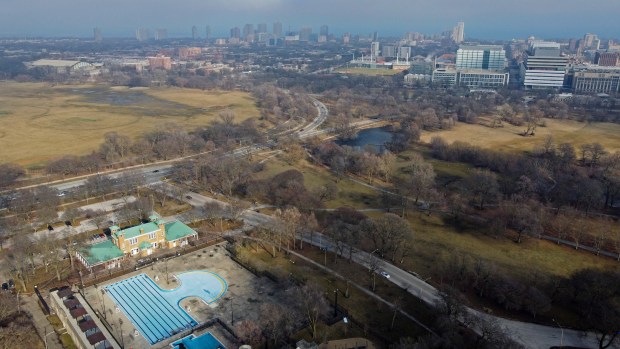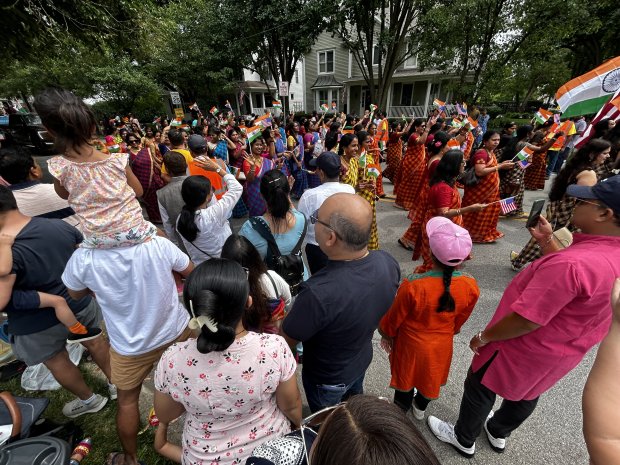For Wilbert King, a South Side native who works in violence prevention, Washington Park is the place where he gathers young people in Chicago every Sunday to play in a softball league. He credits the availability of the softball fields for pointing his own life in the right direction and wants to do the same for others.
“It’s the biggest use of the park,” King said of the softball diamonds. “People come from all over Chicago, and there’s never any incidents.”
On Saturday afternoon, King was one of dozens of people to see and the Chicago Park District’s proposed framework plan for the future of Washington Park as part of the district’s larger strategic plan for parks across the city.
The 345-acre South Side park, bound by 51st Street, King Drive, 60th Street, and Cottage Grove Avenue, connects to Jackson Park on the lakefront through Midway Plaisance Park, creating a grand park space that covers more than 1,000 acres.
The park district sought feedback on six key areas of the space, including plans for bike circulation paths, athletic areas, the Morgan Drive entrance, the fieldhouse, the pool, and lagoon on the south side. Areas were split into six stations inside the park’s fieldhouse with a large visual rendering at each one. Visitors were invited to pick up a pamphlet and stop at each station before submitting a list of what impressed them in the renderings.
Changes are crafted to protect the historic nature of the park, designed in 1871, but also built on the community needs and attract people throughout the city to use the space, according to the Park District.
“They are in communities, but they benefit everyone,” said Cecilia Butler, president of the Washington Park Advisory Council. “It’s up to you to use it or go elsewhere
Park District superintendent Rosa Escareño said turnout at the session was impressive, adding that despite the parks being used less in the winter, people can be more excited about what possibilities lie ahead for the green space.
“It is just super exciting that people are just so passionate about their parks,” Escareño said. “Our framework plan provides the park district the direction that we should go, and when that direction is fed by the people that live in these neighborhoods, it is really an important part of this process.”
The softball fields were one of the most talked about elements of the park, with several post-it notes stuck on boards advocating to preserve them. “We need them all,” King said.
Donald Hendrix also runs a softball league at Washington Park for the Chicago Transit Authority, where he worked as a mechanic before retirement. He said more than 1,000 people in the league play each Sunday morning, spreading out amongst at least five diamonds.
.”We get players and all of their families come to watch, too,” Hendrix said.
The park district last laid out a framework in 2002. A new framework will build on that previous plan and continue to improve the park over time based on how neighborhood needs, city funding and fundraising efforts change.
Donna Hampton-Smith, a Washington Park homeowner for 33 years, said she has seen many undelivered promises from the decades-old framework plan, making her skeptical for the upcoming redesign.
“Don’t get me wrong, it’s a beautiful park, a gorgeous park, but it’s hard to be positive about it,” Hampton-Smith said of the presented plan for improvements.
At the open house, Hampton-Smith viewed the illustrated maps of options for future use, filling out a feedback card on her way out, but ultimately she said she didn’t feel the event was a productive way to hear from neighbors in the community.
“They are hearing from a lot of people who don’t live in Washington Park here,” Hampton-Smith said, noting that many people she knew nearby did not hear of the event. “I hope they have a way to listen to people who actually live in Washington Park.”
Escareño said the city listens to input from anyone who uses Washington Park.
Butler agreed that she has seen “barely any change” in more than 20 years, but she is hopeful that stronger communication with the city can result in changes that residents want.
“Chicago has one of the best park systems in the world, and they are all about uplifting the community,” Butler said.
Once feedback is collected, the city will identify what projects can be funded first and how much funding exists to fulfill the park’s needs, Escareño said
“It’s an opportunity to refocus ourselves, to identify with the community and say ‘where do we focus the money and how much is available and can they help us?”




